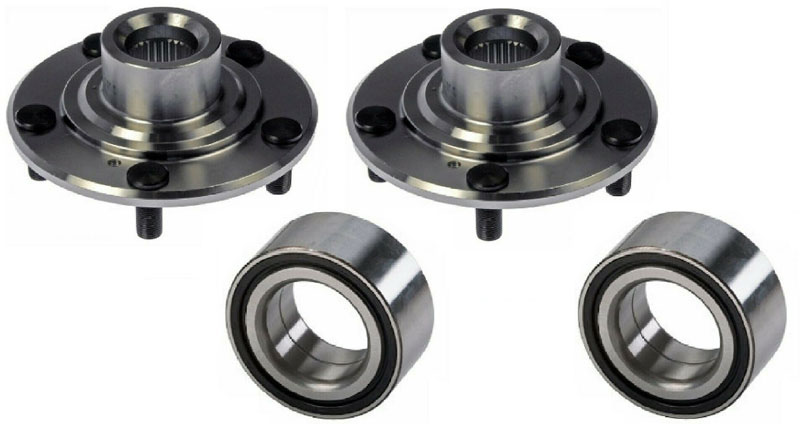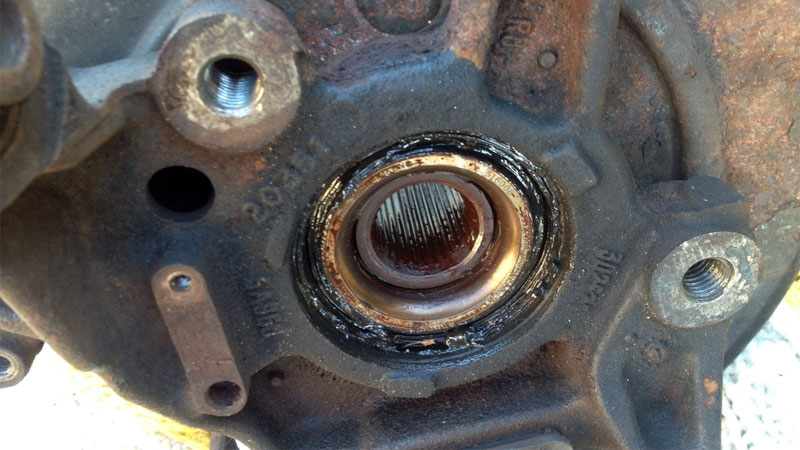Cars are equipped with front wheel bearings and rear wheel bearings. In fact, any machine with moving wheels is likely going to have wheel bearings.
In vehicles, wheel bearings reduce the amount of friction in the spinning wheels. Otherwise, if you were to have a lot of friction, there would be a lot of heat generated in the wheels and tires of the vehicle. Wheel bearings will reduce this heat by serving as a lubricant for your wheels and tires.
You will find these wheel bearings installed in the drive axle of each wheel and in the steering assembly. In most cases, the wheel bearings will stay good for several years, depending on how often you drive your vehicle.
However, wheel bearings do start to go bad when they lose their ability to lubricate the wheels and tires due to different causes. If this were to happen, then your wheels and tires would generate a lot more heat than normal.
Not only that, the rotation of your wheels and tires would not be so smooth anymore. You will notice a lot of disturbing symptoms coming from your entire steering assembly. These are symptoms that you should not ignore because they will only get worse as time goes on.
See Also: Wheel Bearing Replacement Cost (Front and Rear)
What is a Wheel Bearing?

In simple words, a wheel bearing is a metallic ring that helps your car’s wheel rotate smoothly and with minimal friction. Though the shape and the type of the bearing may differ from vehicle to vehicle but their purpose always remain the same – to help rotate the wheel.
The wheel bearing is installed in the hub where it fits precisely so that it can perform its function of spinning the wheel. Over time, wheel bearings lose their strength and become weak. As they get weak, they make noise and this is where you have to figure it out, and replace them.
What Damages a Wheel Bearing?
It is destroyed by water and excessive heat. Though all the bearings are properly sealed, wear and tear eventually damages the seal.
When a seal is damaged, water and debris enter the bearing and it fails to perform its function.
Top 5 Bad Wheel Bearing Symptoms
Below are five of the most common symptoms associated with bad front or rear wheel bearings.
1) Shakiness

If the wheel bearings are damaged then you are going to experience a lot of shakiness and vibrations coming from your wheels as you’re driving. This is due to the wheels having more friction which causes them to move out of place.
This shakiness will only get worse if the wheel bearings are not replaced. The vibrations are felt in the entire car making it different than if only your steering wheel was shaking.
2) Car Slows Down

You may be driving along one day and find that your car will suddenly slow down on its own. This is often due to the wheel bearings being worn out or defective. They are not allowing your wheels to move smoothly anymore, so the movements of the wheel are slowing down.
If you let this problem continue, it will eventually lead to the wheels not moving whatsoever. This means the car won’t move and you will be stuck until you replace the bearings which are causing the issue. A sticky brake caliper may also be the culprit.
3) Grinding Noises

When you don’t have good wheel bearings to serve as a lubricant for the wheels and tires, there is going to be a lot of metal making contact with other metal. This will not only cause too much friction, but it will generate grinding noise.
These grinding noises will only get louder and louder as you drive faster and since they are coming from your wheels, other drivers will definitely take notice making it slightly embarrassing. So get the bearings replaced as soon as possible.
For more information, see the section below on wheel bearing noise.
4) Tire Wear

The more you drive with bad wheel bearings in your steering assembly, the more your tires will become worn. However, the tires will be unevenly worn which is actually quite unusual.
All four tires are supposed to be evenly aligned on the ground which means they should all be getting evenly worn. But since bad wheel bearings cause alignment issues, the corresponding tire will show signs of inner wear or outer wear.
The tire that has the most wear is usually the one that has the bad wheel bearing which needs to be replaced.
5) Steering Wheel Vibrations

When you have shakiness coming from the wheels, then you are bound to feel vibrations in the steering wheel as you’re holding it. But rather than feeling the vibrations at higher speeds like when the tires are unbalanced, you will feel the vibrations at slower speeds when it is a wheel bearing issue.
Eventually, the vibrations will get worse as time goes on and they will get worse as you accelerate. You’ll obviously want to replace the bad wheel bearings before it gets to this point.
Diagnosing Wheel Bearing Noise
Initially, the noise will be too quiet to hear. You will not be able to notice it, but within a few weeks, the noise will get louder. Soon, you will hear a constant noise throughout the journey.
Let’s be clear on this, the wheel bearing noise in your car is one of the hardest to diagnose. Why? Because you have to drive the car to hear the noise. When the car stops, the noise stops.
There are, however, a few ways to diagnose the wheel bearing noise in your car.
1) Listen While Driving
When you are in the driving seat, listen closely. Do you hear a rotating sound that is rhythmic and increases with the speed? Does it gets louder and then disappears at certain speeds? If so, you probably have noise from a wheel bearing.
2) Testing on a Lift
With another person in the vehicle, get your car on a lift and have them run it at a decent speed. Listen to the noise from all the wheels. You will be able to point which wheel bearing are making noise.
Don’t attempt this without the right setup or experience.
3) Sway Test
This is a pro method where you have to drive your car at 50 mph and sway your car to the right and then to left, and so on. Do it slowly. If the rhythmic sound shifts from left to right, your car has a wheel bearing issue.
To spot the exact wheel which has the issue, listen closely when you sway car to the left if noise decreases the issue is on the right side. If the noise decreases when you sway to the right, one of the wheel bearings on the left side has failed.
Once you have spotted that one or more wheel bearings are making noise, the only solution is to replace the damaged ones, and your ride will become noiseless once again.
- Power Windows Not Working? (10 Common Causes and How to Fix) - February 8, 2024
- 14 Causes of a Car Losing Power When Accelerating - January 23, 2024
- 13 Causes of Poor Gas Mileage (Increase Your MPG) - December 13, 2023

